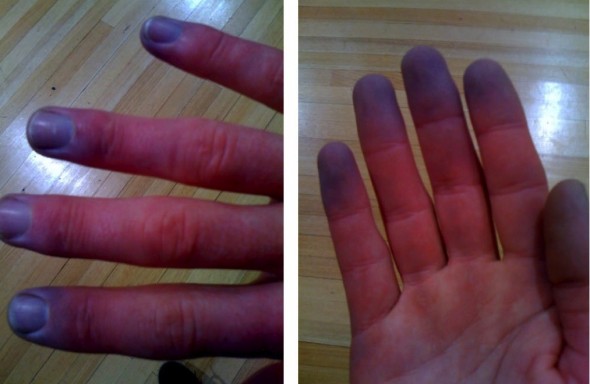Reynaud disease also known as Reynaud’s disorder, Reynaud’s syndrome or Reynaud phenomenon is a very rare condition that generally affects arteries. Arteries are blood vessels that are responsible in supplying blood from the heart to various parts of the body. With Reynaud disease, the arteries found in the skin will narrow thus resulting to limited blood circulation to fingers and toes. Aside from skin and toes, it may also affect the nose, ears and lips.
Due to lack of blood supply, the affected area may turn to white then bluish in color. As blood supply gradually returns, the person may feel numbness.
This rare condition is often seen living in those places that have colder climate and more women are at risk of developing this disorder. However, there are some cases, where a person with Reynaud may not also be able to stand in rooms with cold air conditioning or cannot even hold a cold glass of water.
Clinically, there are two classifications: the classified primary Reynaud and the secondary Reynaud. Between the two, primary is more common and less severe than secondary.
What are the symptoms of reynaud disease?
Reynaud’s disorder is not just an ordinary frostbite due to cold winter. The symptoms may vary according to frequency and severity of attack. Some of the symptoms may include:
- Cold fingers
- Cold toes
- Fingers may turn pale white then bluish in color. The sudden change in color is the response of your body to cold weather or to stress
- The affected area may feel numb
- There is tingling sensation in the affected area.
During Reynaud’s attack, your fingers or toes may turn white, then blue and the area may feel extra cold and numb. Sense of touch is very dull. When the blood circulation normalizes, the skin may turn to red and may have swelling. The change of skin color is the most common symptom of Reynaud disease however, not all people with the disorder may experience the three change of skin color.
It may not also affect all the fingers, some individuals may observe that only two or three of their fingers are affected while the rest are not.
There are also two types of Reynaud: Primary and Secondary.
- Primary Reynaud’s affect individuals without any clear cause. Unlike the secondary, this condition is not associated with any health problem.
- Secondary is more known as Reynaud phenomenon. The cause of this condition is often a serious health problem. This often affects those over forty years of age and above. The symptoms are the same as the primary but only it is more severe in nature.
What are the causes of reynaud disease?
The exact cause of Reynaud disease is not clear. However, some factors may cause the condition. Some of the possible causes may include:
- Severe cold temperature. When body is exposed to severe cold temperature, the blood supply to the fingers and toes are lesser in order to preserve the body temperature. However, with Reynaud, the body’s reaction to cold weather is overly exaggerated.
- Stress is another possible culprit of the attack. When a person with Reynaud is under stress, the body reaction is also exaggerated thus leading to symptoms of Reynaud.
- Injuries to hands and feet like frostbite or fracture can also be another cause.
- Smoking also restricts the blood vessels. Restricting the blood vessels through smoking and second hand smoking is another possible cause.
- Some type of medications is linked with Reynaud phenomenon. Some of these are beta blockers, medications use to treat migraine and some chemotherapy agents. Some cold medications are also found to have linked to secondary Reynaud’s. However, more tests are needed to know the exact role of these medications to Reynaud.
- Exposure to chemicals is another possible cause. Individuals who are exposed to vinyl chloride are susceptible to develop scleroderma. Reynaud syndrome can be a part of scleroderma.
- People with thyroid problems may also exhibit some symptoms of Reynaud.
Secondary Reynaud is cause by underlying health conditions. Some of the diseases that may cause secondary Reynaud disease may include:
- Rheumatoid arthritis is often related to secondary Reynaud. Oftentimes, the appearance of Reynaud is the initial sign of inflammation of joints
- Sjogen syndrome can also be underlying cause. Some cases of Sjogen syndrome also feel bothersome symptoms of Reynaud phenomenon.
- Lupus, an autoimmune disease, is often a common cause of Reynaud. Most cases of lupus also suffer from the secondary Reynaud.
- Buerger’s disease, inflammation of the blood vessels found in the hands is also related.
- Carpal tunnel syndrome may make an individual at risk of developing Reynaud phenomenon.
